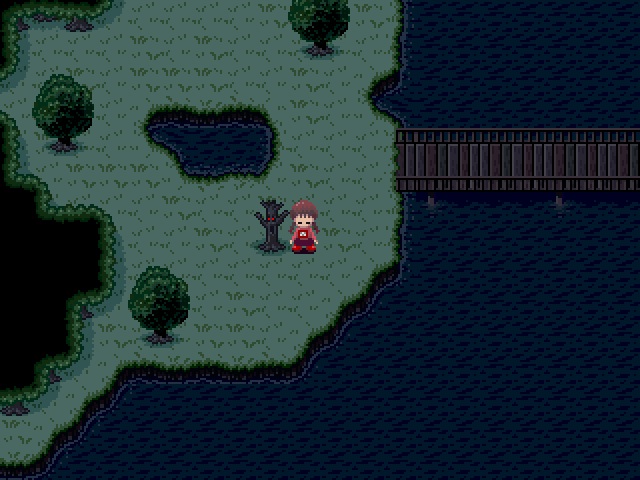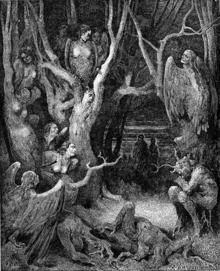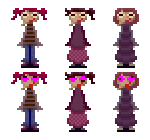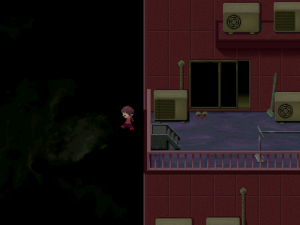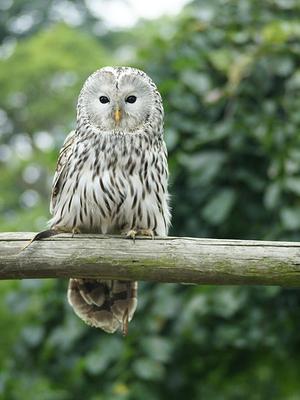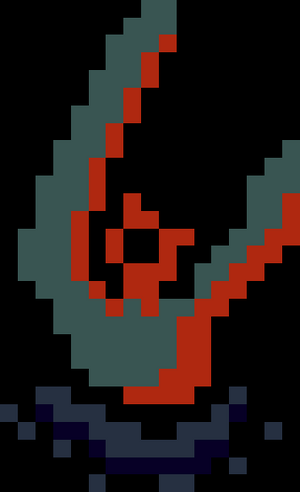>Mt.kiki (Created page with " thumb|left|640px|Witch's Island(The Wood of the Self-Murderers) ==The Dense Woods ([[List_of_Characters#.28Unnamed.29_5|...") |
mNo edit summary |
||
| (18 intermediate revisions by 5 users not shown) | |||
| Line 31: | Line 31: | ||
==[[ | |||
==[[Yume Nikki:Kimajo|Kimajo]]([http://en.wikipedia.org/wiki/The_Wood_of_the_Self-Murderers:_The_Harpies_and_the_Suicides <u>The Wood of the Self-Murderers: The Harpies and the Suicides</u>])== | |||
[[File:487px-DVinfernoForestOfSuicides_m.jpg|thumb|right|220px|Harpies in the Forest of Suicides, an 1861 engraving by Gustave Doré, illustrates the same canto of the Inferno.]] | |||
Harpies remained vivid in the Middle Ages. | Harpies remained vivid in the Middle Ages. | ||
In his Inferno, XIII, [http://en.wikipedia.org/wiki/Dante <u>Dante</u>] envisages the tortured wood infested with harpies, where the [http://en.wikipedia.org/wiki/Suicide <u>suicides</u>] have their punishment in the seventh ring of Hell: | In his Inferno, XIII, [http://en.wikipedia.org/wiki/Dante <u>Dante</u>] envisages the tortured wood infested with harpies, where the [http://en.wikipedia.org/wiki/Suicide <u>suicides</u>] have their punishment in the seventh ring of Hell: | ||
| Line 45: | Line 46: | ||
They have broad wings, a human neck and face, | They have broad wings, a human neck and face, | ||
Clawed feet and swollen, feathered bellies; they caw<br />Their lamentations in the eerie trees.<sup class="reference" id="cite_ref-6" sizcache09779979311431767="68 141 69" sizset="false">[http://en.wikipedia.org/wiki/Harpy#cite_note-6 <u>[6</u>]]</sup> | |||
<sup class="reference" id="cite_ref-6" sizcache09779979311431767="68 141 69" sizset="false">[[File:Kimajo_ch.jpg|thumb|Kimajo]]</sup> | |||
<sup class="reference" id="cite_ref-6" sizcache09779979311431767="68 141 69" sizset="false"> </sup> | |||
<u> </u> | |||
[http://en.wikipedia.org/wiki/William_Blake <u>William Blake</u>] was inspired by Dante's description in his pencil, ink and watercolour "[http://en.wikipedia.org/wiki/The_Wood_of_the_Self-Murderers:_The_Harpies_and_the_Suicides <u>The Wood of the Self-Murderers: The Harpies and the Suicides</u>]" (Tate Gallery, London) | |||
[http://yumenikki.wikia.com/wiki/The_Dense_Woods(name)#The_Dense_Woods.C2.A0.28.E6.A8.B9.E6.B5.B7.29 1 The Dense Woods (樹海)] | |||
※Slang which points out the thing in a mountain or woods which commits suicide from Aoki-hara being made into the famous place of suicide.("[http://en.wikipedia.org/wiki/The_Wood_of_the_Self-Murderers:_The_Harpies_and_the_Suicides <u>The Wood of the Self-Murderers: The Harpies and the Suicides</u>]") | |||
==[[Yume Nikki:Toriningen|Toriningen]] ([http://en.wikipedia.org/wiki/Harpy Harpy])== | |||
In [http://en.wikipedia.org/wiki/Greek_mythology <u>Greek mythology</u>], a harpy ([http://en.wikipedia.org/wiki/Greek_language <u>Greek</u>]: ἅρπυια, harpyia, pronounced [http://en.wikipedia.org/wiki/Help:IPA_for_Greek <u>[hárpuja</u>]]; [http://en.wikipedia.org/wiki/Latin_language <u>Latin</u>]: harpeia) was one of the winged spirits best known for constantly stealing all food from [http://en.wikipedia.org/wiki/Phineus <u>Phineus</u>]. [[File:Toriningen_all_anim_lunatic.gif|thumb|Harpy three sister?]] | |||
The literal meaning of the word seems to be "that which snatches" as it comes from the Greek word harpazein (ἁρπάζειν), which means "to snatch". | |||
[[File:The_Jump.png|thumb|left|The Ending(madotsuki)]] | |||
[http://yumenikki.wikia.com/wiki/Witch%27s_Island(name)#Kimajo.28The_Wood_of_the_Self-Murderers:_The_Harpies_and_the_Suicides.29 1 Kimajo(The Wood of the Self-Murderers: The Harpies and the Suicides)] | |||
※ "[http://en.wikipedia.org/wiki/The_Wood_of_the_Self-Murderers:_The_Harpies_and_the_Suicides <u>The Wood of the Self-Murderers: The Harpies and the Suicides</u>]" ⇒Toriningen ([http://en.wikipedia.org/wiki/Harpy Harpy]) and the [[Yume Nikki:Madotsuki|Madotsuki]](The Suicides) | |||
==[[Witch's Island]]([http://en.wikipedia.org/wiki/Zephyros#West_wind Anemoi])== | ==[[Yume Nikki:Witch's Island|Witch's Island]]([http://en.wikipedia.org/wiki/Zephyros#West_wind Anemoi])== | ||
※Dress and hair which hang over the wind from "the East([http://en.wikipedia.org/wiki/Zephyros#West_wind Anemoi] | ※Dress and hair which hang over the wind from "the East([http://en.wikipedia.org/wiki/Zephyros#West_wind Anemoi])". | ||
Added by [http://www.youtube.com/user/pumoo?feature=watch <u>pumoo milk</u>][[File:Witch's_Island(Witch).png|thumb|Dress and hair which hang over the wind from the east. | Added by [http://www.youtube.com/user/pumoo?feature=watch <u>pumoo milk</u>][[File:Witch's_Island(Witch).png|thumb|Dress and hair which hang over the wind from the east. | ||
]] | ]] | ||
[[File:Witch's Island(Euros)|thumb|left|335px|Blow wind from East]] | |||
| Line 93: | Line 111: | ||
ローマ神話においてエウロスに相当する神格はウルトゥルヌス (Vulturnus) であった。 | ローマ神話においてエウロスに相当する神格はウルトゥルヌス (Vulturnus) であった。 | ||
==[[Yume Nikki:Effects#Witch (まじょ)|Witch]]([http://en.wikipedia.org/wiki/Witch-hunt Witch-hunt])== | |||
[[File:Witch.png|thumb|Witch-hunt(Witch)]] | |||
A '''witch-hunt''' is a search for witches or evidence of [http://en.wikipedia.org/wiki/Witchcraft <u>witchcraft</u>], often involving [http://en.wikipedia.org/wiki/Moral_panic <u>moral panic</u>],<sup class="reference" id="cite_ref-1">[http://en.wikipedia.org/wiki/Witch-hunt#cite_note-1 <u>[1</u>]]</sup> or [http://en.wikipedia.org/wiki/Mass_hysteria <u>mass hysteria</u>].<sup class="reference" id="cite_ref-2">[http://en.wikipedia.org/wiki/Witch-hunt#cite_note-2 <u>[2</u>]]</sup> Before 1750 it was legally sanctioned and involving official '''witchcraft trials'''. The [http://en.wikipedia.org/wiki/Witch_trials_in_the_Early_Modern_period <u>classical period of witchhunts</u>] in [http://en.wikipedia.org/wiki/Early_Modern_Europe <u>Europe</u>] and [http://en.wikipedia.org/wiki/Colonial_North_America <u>North America</u>] falls into the [http://en.wikipedia.org/wiki/Early_Modern_period <u>Early Modern period</u>] or about 1480 to 1750, spanning the upheavals of the [http://en.wikipedia.org/wiki/Protestant_Reformation <u>Reformation</u>] and the [http://en.wikipedia.org/wiki/Thirty_Years%27_War <u>Thirty Years' War</u>], resulting in an estimated 40,000 to 60,000 executions.<sup class="reference" id="cite_ref-ReferenceA_3-0">[http://en.wikipedia.org/wiki/Witch-hunt#cite_note-ReferenceA-3 <u>[3</u>]]</sup> | |||
== | |||
==Witch's Island([http://en.wikipedia.org/wiki/Witch-hunt Witch-hunt])== | |||
[[File:Strix_uralensis.jpg|thumb|Ural Owl in Prague Zoo]] | [[File:Strix_uralensis.jpg|thumb|Ural Owl in Prague Zoo]] | ||
| Line 101: | Line 124: | ||
[http://ja.wikipedia.org/wiki/%E9%AD%94%E5%A5%B3%E7%8B%A9%E3%82%8A#.E3.83.A8.E3.83.BC.E3.83.AD.E3.83.83.E3.83.91.E3.81.AB.E3.81.8A.E3.81.91.E3.82.8B.E9.AD.94.E5.A5.B3.E7.8B.A9.E3.82.8A <u>1 ヨーロッパにおける魔女狩り</u>] | [http://ja.wikipedia.org/wiki/%E9%AD%94%E5%A5%B3%E7%8B%A9%E3%82%8A#.E3.83.A8.E3.83.BC.E3.83.AD.E3.83.83.E3.83.91.E3.81.AB.E3.81.8A.E3.81.91.E3.82.8B.E9.AD.94.E5.A5.B3.E7.8B.A9.E3.82.8A <u>1 ヨーロッパにおける魔女狩り</u>] | ||
女性研究家[http://ja.wikipedia.org/w/index.php?title=%E3%83%9E%E3%83%83%E3%82%AF%E3%82%B9%E3%83%BB%E3%83%80%E3%82%B7%E3%83%A5%E3%83%BC&action=edit&redlink=1 <u>マックス・ダシュー</u>](Max Dashu)によれば、中世の人々が持っていた魔女観はキリスト教以前の社会にさかのぼるものも見られるという。たとえばローマの民族宗教であった[http://ja.wikipedia.org/wiki/%E3%83%90%E3%83%83%E3%82%AF%E3%82%B9_(%E3%83%AD%E3%83%BC%E3%83%9E%E7%A5%9E%E8%A9%B1) <u>バッカス</u>]信仰やローマの伝説に出る怪物[http://ja.wikipedia.org/w/index.php?title=%E3%82%B9%E3%83%88%E3%83%AA%E3%82%AF%E3%82%B9&action=edit&redlink=1 <u>ストリクス</u>](女性の姿をし、[http://ja.wikipedia.org/wiki/%E3%81%B5%E3%81%8F%E3%82%8D%E3%81%86 <u>ふくろう</u>]に化けて空を飛ぶとされた)と魔女像との関係が指摘されている。 | 女性研究家[http://ja.wikipedia.org/w/index.php?title=%E3%83%9E%E3%83%83%E3%82%AF%E3%82%B9%E3%83%BB%E3%83%80%E3%82%B7%E3%83%A5%E3%83%BC&action=edit&redlink=1 <u>マックス・ダシュー</u>](Max Dashu)によれば、中世の人々が持っていた魔女観はキリスト教以前の社会にさかのぼるものも見られるという。たとえばローマの民族宗教であった[http://ja.wikipedia.org/wiki/%E3%83%90%E3%83%83%E3%82%AF%E3%82%B9_(%E3%83%AD%E3%83%BC%E3%83%9E%E7%A5%9E%E8%A9%B1) <u>バッカス</u>]信仰やローマの伝説に出る怪物[http://ja.wikipedia.org/w/index.php?title=%E3%82%B9%E3%83%88%E3%83%AA%E3%82%AF%E3%82%B9&action=edit&redlink=1 <u>ストリクス</u>](女性の姿をし、[http://ja.wikipedia.org/wiki/%E3%81%B5%E3%81%8F%E3%82%8D%E3%81%86 <u>ふくろう</u>]に化けて空を飛ぶとされた)と魔女像との関係が指摘されている。 | ||
For example, the relation of monster [http://ja.wikipedia.org/w/index.php?title=%E3%82%B9%E3%83%88%E3%83%AA%E3%82%AF%E3%82%B9&action=edit&redlink=1 <u>ストリクス</u>] (it was presupposed that a female figure was carried out, it was changed into an [http://en.wikipedia.org/wiki/Ural_Owl owl], and it flew in the sky) and the witch image which appear in the tradition of the [http://en.wikipedia.org/wiki/Bacchanalia Bacchus] faith which was the race religion of Rome, or Rome is pointed out. | For example, the relation of monster [http://ja.wikipedia.org/w/index.php?title=%E3%82%B9%E3%83%88%E3%83%AA%E3%82%AF%E3%82%B9&action=edit&redlink=1 <u>ストリクス</u>] (it was presupposed that a female figure was carried out, it was changed into an [http://en.wikipedia.org/wiki/Ural_Owl owl], and it flew in the sky) and the witch image which appear in the tradition of the [http://en.wikipedia.org/wiki/Bacchanalia Bacchus] faith which was the race religion of Rome, or Rome is pointed out. | ||
[http://yumenikki.wikia.com/wiki/Witch%27s_Island(name)#Witch.28Witch-hunt.29 4 Witch(Witch-hunt)] | |||
※The nose at Which([http://en.wikipedia.org/wiki/Witch-hunt Witch-hunt]) the White-skin witch was displeased is "a beak([http://en.wikipedia.org/wiki/Ural_Owl Ural Owl])" | |||
http:// | ==Witch's Island([http://en.wikipedia.org/wiki/Ural_Owl Ural Owl])== | ||
[http://ja.wikipedia.org/wiki/%E3%81%B5%E3%81%8F%E3%82%8D%E3%81%86#.E4.BA.BA.E9.96.93.E3.81.A8.E3.81.AE.E9.96.A2.E4.BF.82 <u>5 人間との関係</u>] | [http://ja.wikipedia.org/wiki/%E3%81%B5%E3%81%8F%E3%82%8D%E3%81%86#.E4.BA.BA.E9.96.93.E3.81.A8.E3.81.AE.E9.96.A2.E4.BF.82 <u>5 人間との関係</u>] | ||
| Line 117: | Line 138: | ||
In Japan and China, since it was thought that a mother was eaten and it grew up "an undutiful bird", 梟 is called.<br />Nichiren is mentioning this point in writing repeatedly [1]. | In Japan and China, since it was thought that a mother was eaten and it grew up "an undutiful bird", 梟 is called.<br />Nichiren is mentioning this point in writing repeatedly [1]. | ||
== | [http://yumenikki.wikia.com/wiki/Hell(name)#Hell.28Caesarean_section.29 4 Hell(Caesarean section)] | ||
※Madotsuki havn't her mother, If it passed away in a certain accident and childbirth? | |||
==Witch's Island([http://en.wiktionary.org/wiki/sink_or_swim Sink or Swim])== | |||
[[File:Witch's_Island(sink_or_swim).png|thumb|Witch's Island(Sink or Swim)]] | [[File:Witch's_Island(sink_or_swim).png|thumb|Witch's Island(Sink or Swim)]] | ||
[http://en.wiktionary.org/wiki/sink_or_swim#English <u>1 English</u>] | [http://en.wiktionary.org/wiki/sink_or_swim#English <u>1 English</u>] | ||
| Line 123: | Line 147: | ||
*[http://en.wiktionary.org/wiki/sink_or_swim#Verb <u>1.2 Verb</u>] | *[http://en.wiktionary.org/wiki/sink_or_swim#Verb <u>1.2 Verb</u>] | ||
Possibly from the practice of throwing a suspected witch into water. | Possibly from the practice of throwing a suspected witch into water. | ||
[http://en.wiktionary.org/wiki/sink <u>sink</u>] or [http://en.wiktionary.org/wiki/swim <u>swim</u>] | [http://en.wiktionary.org/wiki/sink <u>sink</u>] or [http://en.wiktionary.org/wiki/swim <u>swim</u>] | ||
#([http://en.wiktionary.org/wiki/Appendix:Glossary#idiomatic <u>idiomatic</u>]) To [http://en.wiktionary.org/wiki/fail <u>fail</u>] or [http://en.wiktionary.org/wiki/succeed <u>succeed</u>], no matter what. | #([http://en.wiktionary.org/wiki/Appendix:Glossary#idiomatic <u>idiomatic</u>]) To [http://en.wiktionary.org/wiki/fail <u>fail</u>] or [http://en.wiktionary.org/wiki/succeed <u>succeed</u>], no matter what. | ||
[http://yumenikki.wikia.com/wiki/Witch%27s_Island(name)#Witch.28Witch-hunt.29 4 Witch(Witch-hunt)] | |||
※Effects(Witch) ⇒ Witch's Island([http://en.wikipedia.org/wiki/Witch-hunt Witch-hunt]) | |||
[[Category:Yume Nikki theoretical discussions by Mt.kiki]] | |||
Latest revision as of 02:54, 24 April 2023
Kimajo(The Wood of the Self-Murderers: The Harpies and the Suicides)
Harpies remained vivid in the Middle Ages.
In his Inferno, XIII, Dante envisages the tortured wood infested with harpies, where the suicides have their punishment in the seventh ring of Hell:
Here the repellent harpies make their nests,
Who drove the Trojans from the Strophades
With dire announcements of the coming woe.
They have broad wings, a human neck and face,
Clawed feet and swollen, feathered bellies; they caw
Their lamentations in the eerie trees.[6]
William Blake was inspired by Dante's description in his pencil, ink and watercolour "The Wood of the Self-Murderers: The Harpies and the Suicides" (Tate Gallery, London)
※Slang which points out the thing in a mountain or woods which commits suicide from Aoki-hara being made into the famous place of suicide.("The Wood of the Self-Murderers: The Harpies and the Suicides")
Toriningen (Harpy)
In Greek mythology, a harpy (Greek: ἅρπυια, harpyia, pronounced [hárpuja]; Latin: harpeia) was one of the winged spirits best known for constantly stealing all food from Phineus.
The literal meaning of the word seems to be "that which snatches" as it comes from the Greek word harpazein (ἁρπάζειν), which means "to snatch".
1 Kimajo(The Wood of the Self-Murderers: The Harpies and the Suicides)
※ "The Wood of the Self-Murderers: The Harpies and the Suicides" ⇒Toriningen (Harpy) and the Madotsuki(The Suicides)
Witch's Island(Anemoi)
※Dress and hair which hang over the wind from "the East(Anemoi)".
Added by pumoo milk
Eurus (Greek: Εύρος, Eúros) was the Greek deity representing the unlucky east wind. He was thought to bring warmth and rain, and his symbol was an inverted vase, spilling water. His Roman counterpart was Vulturnus (not to be confused with Volturnus, a tribal river-god who later became a Roman deity of the River Tiber).
エウロス(Εύρος, Euros)は、不吉な東風を表す神である。エウロスは暖気と雨を運んでくる神と考えられており、さかさまになって水をこぼしている壺がエウロスの象徴であった。
ローマ神話においてエウロスに相当する神格はウルトゥルヌス (Vulturnus) であった。
Witch(Witch-hunt)
A witch-hunt is a search for witches or evidence of witchcraft, often involving moral panic,[1] or mass hysteria.[2] Before 1750 it was legally sanctioned and involving official witchcraft trials. The classical period of witchhunts in Europe and North America falls into the Early Modern period or about 1480 to 1750, spanning the upheavals of the Reformation and the Thirty Years' War, resulting in an estimated 40,000 to 60,000 executions.[3]
Witch's Island(Witch-hunt)
1 ヨーロッパにおける魔女狩り 女性研究家マックス・ダシュー(Max Dashu)によれば、中世の人々が持っていた魔女観はキリスト教以前の社会にさかのぼるものも見られるという。たとえばローマの民族宗教であったバッカス信仰やローマの伝説に出る怪物ストリクス(女性の姿をし、ふくろうに化けて空を飛ぶとされた)と魔女像との関係が指摘されている。
For example, the relation of monster ストリクス (it was presupposed that a female figure was carried out, it was changed into an owl, and it flew in the sky) and the witch image which appear in the tradition of the Bacchus faith which was the race religion of Rome, or Rome is pointed out.
4 Witch(Witch-hunt) ※The nose at Which(Witch-hunt) the White-skin witch was displeased is "a beak(Ural Owl)"
Witch's Island(Ural Owl)
日本と中国では、梟は母親を食べて成長すると考えられていた為「不孝鳥」と呼ばれる。日蓮は著作に於いて何度もこの点を挙げている[1]。
- 開目抄 譬へば幼稚の父母をのる、父母これをすつるや。梟鳥が母を食、母これをすてず。破鏡父をがいす、父これにしたがふ。畜生すら猶かくのごとし
In Japan and China, since it was thought that a mother was eaten and it grew up "an undutiful bird", 梟 is called.
Nichiren is mentioning this point in writing repeatedly [1].
4 Hell(Caesarean section) ※Madotsuki havn't her mother, If it passed away in a certain accident and childbirth?
Witch's Island(Sink or Swim)
Possibly from the practice of throwing a suspected witch into water.
sink or swim
※Effects(Witch) ⇒ Witch's Island(Witch-hunt)

